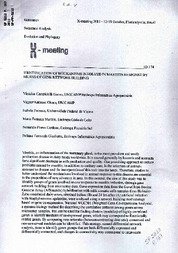Identification of mechanisms involved in mastitis response by means of gene network building.
Identification of mechanisms involved in mastitis response by means of gene network building.
Author(s): GOZZO, V. C.; OKURA, V. K.; FONSECA, I.; MARTINS, M. F.; CARDOSO, F. F.; GIACHETTO, P. F.
Publication year: 2011
Types of publication: Abstract in annals or event proceedings
Unit: Embrapa Dairy Cattle
Keywords: Evolution and phylogeny, Expressão gênica, Mastite, genomics, sequence analysis
Observation
Some of Embrapa's publications are published as ePub files. To read them, use or download one of the following free software options to your computer or mobile device. Android: Google Play Books; IOS: iBooks; Windows and Linux: Calibre.
Access other publications
Access the Agricultural Research Database (BDPA) to consult Embrapa's full library collection and records.
Visit Embrapa Bookstore to purchase books and other publications sold by Embrapa.

